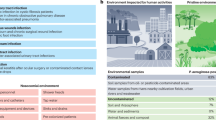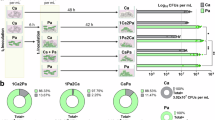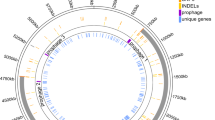Abstract
Inter-kingdom and interspecies interactions are ubiquitous in nature and are important for the survival of species and ecological balance. The investigation of microbe-microbe interactions is essential for understanding the in vivo activities of commensal and pathogenic microorganisms. Candida albicans, a polymorphic fungus, and Pseudomonas aeruginosa, a Gram-negative bacterium, are two opportunistic pathogens that interact in various polymicrobial infections in humans. To determine how P. aeruginosa affects the physiology of C. albicans and vice versa, we compared the proteomes of each species in mixed biofilms versus single-species biofilms. In addition, extracellular proteins were analyzed. We observed that, in mixed biofilms, both species showed differential expression of virulence proteins, multidrug resistance-associated proteins, proteases and cell defense, stress and iron-regulated proteins. Furthermore, in mixed biofilms, both species displayed an increase in mutability compared with monospecific biofilms. This characteristic was correlated with the downregulation of enzymes conferring protection against DNA oxidation. In mixed biofilms, P. aeruginosa regulates its production of various molecules involved in quorum sensing and induces the production of virulence factors (pyoverdine, rhamnolipids and pyocyanin), which are major contributors to the ability of this bacterium to cause disease. Overall, our results indicate that interspecies competition between these opportunistic pathogens enhances the production of virulence factors and increases mutability and thus can alter the course of host-pathogen interactions in polymicrobial infections.
Similar content being viewed by others
Log in or create a free account to read this content
Gain free access to this article, as well as selected content from this journal and more on nature.com
or
References
Andrade-Domínguez A, Salazar E, Vargas-Lagunas M, Kolter R, Encarnación S . (2013). Eco-evolutionary feedbacks drive species interactions. ISME J e-pub ahead of print 5 December 2013 doi:10.1038/ismej.2013.208.
Askew C, Sellam A, Epp E, Hogues H, Mullick A, Nantel A et al. (2009). Transcriptional regulation of carbohydrate metabolism in the human pathogen Candida albicans. PLoS Pathogens 5: e1000612.
Azghani AO, Gray LD, Johnson AR . (1993). A bacterial protease perturbs the paracellular barrier function of transporting epithelial monolayers in culture. Infect Immun 61: 2681–2686.
Bakare N, Rickerts V, Bargon J, Just-Nubling G . (2003). Prevalence of Aspergillus fumigatus and other fungal species in the sputum of adult patients with cystic fibrosis. Mycoses 46: 19–23.
Baron SS, Rowe JJ . (1981). Antibiotic action of pyocyanin. Antimicrob Agents Chemother 20: 814–820.
Bauernfeind A, Bertele RM, Harms K, Horl G, Jungwirth R, Petermuller C et al. (1987). Qualitative and quantitative microbiological analysis of sputa of 102 patients with cystic fibrosis. Infection 15: 270–277.
Be’er A, Zhang HP, Florin E-L, Payne SM, Ben-Jacob E, Swinney HL . (2009). Deadly competition between sibling bacterial colonies. Proc Natl Acad Sci USA 106: 428–433.
Bredenbruch F, Geffers R, Nimtz M, Buer J, Häussler S . (2006). The Pseudomonas aeruginosa quinolone signal (PQS) has an iron-chelating activity. Environ Microbiol 8: 1318–1329.
Brown SM, Howell ML, Vasil ML, Anderson A, Hassett DJ . (1995). Cloning and characterization of the katB gene of Pseudomonas aeruginosa encoding a hydrogen peroxide-inducible catalase: purification of KatB, cellular localization, and demonstration that it is essential for optimal resistance to hydrogen peroxide. J Bacteriol 177: 6536–6544.
Burns JL, Van Dalfsen JM, Shawar RM, Otto KL, Garber RL, Quan JM et al. (1999). Effect of chronic intermittent administration of inhaled tobramycin on respiratory microbial flora in patients with cystic fibrosis. J Infect Dis 179: 1190–1196.
Calderone RA, Fonzi WA . (2001). Virulence factors of Candida albicans. Trends Microbiol 9: 327–335.
Carlisle PL, Kadosh D . (2013). A genome-wide transcriptional analysis of morphology determination in Candida albicans. Mol Biol Cell 24: 246–260.
Chambers A, Packham EA, Graham IR . (1995). Control of glycolytic gene expression in the budding yeast (Saccharomyces cerevisiae). Curr Genet 29: 1–9.
Chen C, Pande K, French SD, Tuch BB, Noble SM . (2011). An iron homeostasis regulatory circuit with reciprocal roles in Candida albicans commensalism and pathogenesis. Cell Host Microbe 10: 118–135.
Cugini C, Calfee MW, Farrow JM, Morales DK, Pesci EC, Hogan Da . (2007). Farnesol, a common sesquiterpene, inhibits PQS production in Pseudomonas aeruginosa. Mol Microbiol 65: 896–906.
Cugini C, Morales DK, Hogan Da . (2010). Candida albicans-produced farnesol stimulates Pseudomonas quinolone signal production in LasR-defective Pseudomonas aeruginosa strains. Microbiology 156: 3096–3107.
Czaran TL, Hoekstra RF, Pagie L . (2002). Chemical warfare between microbes promotes biodiversity. Proc Natl Acad Sci USA 99: 786–790.
Davey ME, O’toole GA . (2000). Microbial biofilms: from ecology to molecular genetics. Microbiol Molecular Biol Rev 64: 847–867.
Diggle SP, Matthijs S, Wright VJ, Fletcher MP, Chhabra SR, Lamont IL et al. (2007). The Pseudomonas aeruginosa 4-quinolone signal molecules HHQ and PQS play multifunctional roles in quorum sensing and iron entrapment. Chem Biol 14: 87–96.
Diggle SP, Winzer K, Chhabra SR, Worrall KE, Cámara M, Williams P . (2003). The Pseudomonas aeruginosa quinolone signal molecule overcomes the cell density-dependency of the quorum sensing hierarchy, regulates rhl-dependent genes at the onset of stationary phase and can be produced in the absence of LasR. Mol Microbiol 50: 29–43.
Dorsman JC, Grivell LA . (1990). Expression of the gene encoding subunit II of yeast QH2: cytochrome c oxidoreductase is regulated by multiple factors. Curr Genet 17: 459–464.
Driffield K, Miller K, Bostock JM, O’Neill aJ, Chopra I . (2008). Increased mutability of Pseudomonas aeruginosa in biofilms. J Antimicrob Chemother 61: 1053–1056.
Duan K, Dammel C, Stein J, Rabin H, Surette MG . (2003). Modulation of Pseudomonas aeruginosa gene expression by host microflora through interspecies communication. Mol Microbiol 50: 1477–1491.
Dumitru R, Hornby JM, Nickerson KW . (2004). Defined anaerobic growth medium for studying Candida albicans basic biology and resistance to eight antifungal drugs. Antimicrob Agents Chemother 48: 2350–2354.
El-Azizi MA, Starks SE, Khardori N . (2004). Interactions of Candida albicans with other Candida spp. and bacteria in the biofilms. J Appl Microbiol 96: 1067–1073.
Encarnación S, Guzmán Y, Dunn MF, Hernández M, Vargas MC, Mora J . (2003). Proteome analysis of aerobic and fermentative metabolism in Rhizobium etli CE3. Proteomics 3: 1077–1085.
Fonzi WA, Irwin MY . (1993). Isogenic strain construction and gene mapping in Candida albicans. Genetics 134: 717–728.
Francs-Small C, Ambard-Bretteville F, Small ID, Rémy R . (1993). Identification of a major soluble protein in mitochondria from nonphotosynthetic tissues as NAD-dependent formate dehydrogenase. Plant Physiol 102: 1171–1177.
Garbeva P, Silby MW, Raaijmakers JM, Levy SB, Boer WDe . (2011). Transcriptional and antagonistic responses of Pseudomonas fluorescens Pf0-1 to phylogenetically different bacterial competitors. ISME J 5: 973–985.
Garibyan L et al. (2003). Use of the rpoB gene to determine the specificity of base substitution mutations on the Escherichia coli chromosome. DNA Repair 2: 593–608.
Gow NA . (1997). Germ tube growth of Candida albicans. Curr Top Med Mycol 8: 43–55.
Gow NA, Brown AJ, Odds FC . (2002). Fungal morphogenesis and host invasion. Curr Opin Microbiol 5: 366–371.
Gupta N, Haque A, Mukhopadhyay G, Narayan RP, Prasad R . (2005). Interactions between bacteria and Candida in the burn wound. Burns 31: 375–378.
Hancock REW, Brinkman FSL . (2002). Function of pseudomonas porins in uptake and efflux. Annu Rev Microbiol 56: 17–38.
Hansen SK, Rainey PB, Haagensen JAJ, Molin S . (2007). Evolution of species interactions in a biofilm community. Nature 445: 533–536.
Harrison F, Paul J, Massey RC, Buckling A . (2008). Interspecific competition and siderophore-mediated cooperation in Pseudomonas aeruginosa. ISME J 2: 49–55.
Hogan DA, Kolter R . (2002). Pseudomonas-Candida interactions: an ecological role for virulence factors. Science 296: 2229–2232.
Hogan DA, Vik A, Kolter R . (2004). A Pseudomonas aeruginosa quorum-sensing molecule influences Candida albicans morphology. Mol Microbiol 54: 1212–1223.
Holloway BW . (1955). Genetic recombination in Pseudomonas aeruginosa. J Gen Microbiol 13: 572–581.
Hsu P, Yang C, Lan C . (2011). Candida albicans Hap43 is a repressor induced under low-iron conditions and is essential for iron-responsive transcriptional regulation and virulence. Eukaryot Cell 10: 207–225.
Hube B . (2006). Infection-associated genes of Candida albicans. Future Microbiol 1: 209–218.
Hughes WT, Kim HK . (1973). Mycoflora in cystic fibrosis: some ecologic aspects of Pseudomonas aeruginosa and Candida albicans. Mycopathol Mycol Appl 50: 261–269.
Hurkman WJ, Tanaka CK . (1986). Solubilization of plant membrane proteins for analysis by two-dimensional gel electrophoresis. Plant Physiol 81: 802–806.
Iglewski BH, Kabat D . (1975). NAD-dependent inhibition of protein synthesis by Pseudomonas aeruginosa toxin. Proc Natl Acad Sci USA 72: 2284–2288.
Jatsenko T, Tover A, Tegova R, Kivisaar M . (2010). Molecular characterization of Rif(r) mutations in Pseudomonas aeruginosa and Pseudomonas putida. Mutat Res Fund Mol Mech Mut 683: 106–114.
Kaleli I, Cevahir N, Demir M, Yildirim U, Sahin R . (2007). Anticandidal activity of Pseudomonas aeruginosa strains isolated from clinical specimens. Mycoses 50: 74–78.
Kerr J . (1994). Inhibition of fungal growth by Pseudomonas aeruginosa and Pseudomonas cepacia isolated from patients with cystic fibrosis. J Infect 28: 305–310.
Kirienko NV, Kirienko DR, Larkins-Ford J, Wählby C, Ruvkun G, Ausubel FM . (2013). Pseudomonas aeruginosa disrupts Caenorhabditis elegans iron homeostasis, causing a hypoxic response and death. Cell Host Microbe 13: 406–416.
Klinke T, Rump A, Pönisch R, Schellenberger W, Müller E-C, Otto A et al. (2008). Identification and characterization of CaApe2-a neutral arginine/alanine/leucine-specific metallo-aminopeptidase from Candida albicans. FEMS Yeast Res 8: 858–869.
Kusch H, Engelmann S, Bode R, Albrecht D, Morschhäuser J, Hecker M . (2008). A proteomic view of Candida albicans yeast cell metabolism in exponential and stationary growth phases. Int J Med Microbiol 298: 291–318.
Lamont IL, Beare PA, Ochsner U, Vasil AI, Vasil ML . (2002). Siderophore-mediated signaling regulates virulence factor production in Pseudomonas aeruginosa. Proc Natl Acad Sci USA 99: 7072–7077.
Lan C-Y, Rodarte G, Murillo LA, Jones T, Davis RW, Dungan J et al. (2004). Regulatory networks affected by iron availability in Candida albicans. Mol Microbiol 53: 1451–1469.
Lau GW, Hassett DJ, Ran H, Kong F . (2004). The role of pyocyanin in Pseudomonas aeruginosa infection. Trends Mol Med 10: 599–606.
Liu H . (2002). Co-regulation of pathogenesis with dimorphism and phenotypic switching in Candida albicans, a commensal and a pathogen. Int J Med Microbiol 292: 299–311.
Loper JE, Buyer JS . (1991). Siderophores in microbial interactions on plant surfaces. Mol Plant Microbe Interact 4: 5–13.
Lynch AS, Robertson GT . (2008). Bacterial and fungal biofilm infections. Annu Rev Med 59: 415–428.
Ma J, Ochsner UA, Klotz MG, Vagira K, Howell ML, Johnson Z et al. (1999). Bacterioferritin A modulates catalase A (KatA) activity and resistance to hydrogen peroxide in Pseudomonas aeruginosa. J Bacteriol 181: 3730–3742.
Marquart ME, Caballero AR, Chomnawang M, Thibodeaux Ba, Twining SS, O’Callaghan RJ . (2005). Identification of a novel secreted protease from Pseudomonas aeruginosa that causes corneal erosions. Invest Ophthalmol Vis Sci 46: 3761–3768.
Mavrodi DV, Blankenfeldt W, Thomashow LS . (2006). Phenazine compounds in fluorescent Pseudomonas spp. biosynthesis and regulation. Annu Rev Phytopathol 44: 417–445.
Minard KI, McAlister-Henn L . (2001). Antioxidant function of cytosolic sources of NADPH in yeast. Free Radic Biol Med 31: 832–843.
Miosga T, Zimmermann FK . (1996). Cloning and characterization of the first two genes of the non-oxidative part of the Saccharomyces cerevisiae pentose-phosphate pathway. Curr Genet 30: 404–409.
Morales DK, Grahl N, Okegbe C . (2013). Control of Candida albicans metabolism and biofilm formation by Pseudomonas aeruginosa phenazines. M Bio 4: e00526-12.
Morales DK, Jacobs NJ, Rajamani S, Krishnamurthy M, Cubillos-Ruiz JR, Hogan DA . (2010). Antifungal mechanisms by which a novel Pseudomonas aeruginosa phenazine toxin kills Candida albicans in biofilms. Mol Microbiol 78: 1379–1392.
Nadal Jimenez P, Koch G, Papaioannou E, Wahjudi M, Krzeslak J, Coenye T et al. (2010). Role of PvdQ in Pseudomonas aeruginosa virulence under iron-limiting conditions. Microbiology 156: 49–59.
Naglik JR, Challacombe SJ, Naglik JR, Challacombe SJ, Hube B . (2003). Candida albicans secreted aspartyl proteinases in virulence and pathogenesis. Microbiol Mol Biol Rev 67: 400–428.
Naglik J, Albrecht A, Bader O, Hube B . (2004). Candida albicans proteinases and host/pathogen interactions. Cell Microbiol 6: 915–926.
Neely AN, Law EJ, Holder IA . (1986). Increased susceptibility to lethal Candida infections in burned mice preinfected with Pseudomonas aeruginosa or pretreated with proteolytic enzymes. Infect Immun 52: 200–204.
O’Malley YQ, Abdalla MY, McCormick ML, Reszka KJ, Denning GM, Britigan BE . (2003). Subcellular localization of Pseudomonas pyocyanin cytotoxicity in human lung epithelial cells. Am J Physiol Lung Cell Mol Physiol 284: L420–L430.
Ochsner UA, Johnson Z, Vasil ML . (2000). Genetics and regulation of two distinct haem-uptake systems, phu and has, in Pseudomonas aeruginosa. Microbiology 146: 185–198.
Oglesby AG, Farrow JM, Lee J-H, Tomaras AP, Greenberg EP, Pesci EC et al. (2008). The influence of iron on Pseudomonas aeruginosa physiology: a regulatory link between iron and quorum sensing. J Biol Chem 283: 15558–15567.
Oliver A, Canton R, Campo P, Baquero F, Blazquez J . (2000). High frequency of hypermutable Pseudomonas aeruginosa in cystic fibrosis lung infection. Science 288: 1251–1253.
Peleg AY, Hogan DA, Mylonakis E . (2010). Medically important bacterial-fungal interactions. Nat Rev Microbiol 8: 340–349.
Pesci EC, Milbank JBJ, Pearson JP, McKnight S, Kende AS, Greenberg EP et al. (1999). Quinolone signaling in the cell-to-cell communication system of Pseudomonas aeruginosa. Proc Natl Acad Sci USA 96: 11229–11234.
Pfaller MA, Diekema DJ . (2007). Epidemiology of invasive candidiasis: a persistent public health problem. Clin Microbiol Rev 20: 133–163.
Price-whelan A, Dietrich LEP, Newman DK . (2007). Pyocyanin alters redox homeostasis and carbon flux through central metabolic pathways in Pseudomonas aeruginosa PA14. J Bacteriol 189: 6372–6381.
Prigneau O, Porta A, Poudrier JA, Colonna-Romano S, Noël T, Maresca B . (2003). Genes involved in beta-oxidation, energy metabolism and glyoxylate cycle are induced by Candida albicans during macrophage infection. Yeast 20: 723–730.
Purschke FG, Hiller E, Trick I, Rupp S . (2012). Flexible survival strategies of Pseudomonas aeruginosa in biofilms result in increased fitness compared with Candida albicans. Mol Cell Proteomics 11: 1652–1669.
Ran H, Hassett DJ, Lau GW . (2003). Human targets of Pseudomonas aeruginosa pyocyanin. Proc Natl Acad Sci USA 100: 14315–14320.
Ratledge C, Dover LG . (2000). Metabolism in pathogenic bacteria. Annu Rev Microbiol 54: 881–941.
Roux D, Gaudry S, Dreyfuss D, El-Benna J, De Prost N, Denamur E et al. (2009). Candida albicans impairs macrophage function and facilitates Pseudomonas aeruginosa pneumonia in rat. Crit Care Med 37: 1062–1067.
Sarthy AV, Mcgonigal T, Coen M, Frost DJ, Meulbroek JA, Goldman RC et al. (1997). Phenotype in Candida albicans of a disruption of the BGL2 gene encoding a 1,3-beta-glucosyltransferase. Microbiology 143 (Pt 2): 367–376.
Shakoury-Elizeh M et al. (2010). Metabolic response to iron deficiency in Saccharomyces cerevisiae. J Biol Chem 285: 14823–14833.
Shakoury-Elizeh M, Protchenko O, Berger A, Cox J, Gable K, Dunn TM et al. (2010). Metabolic response to iron deficiency in Saccharomyces cerevisiae. J Biol Chem 285: 14823–14833.
Sibley CD, Duan K, Fischer C, Parkins MD, Storey DG, Rabin HR et al. (2008). Discerning the complexity of community interactions using a Drosophila model of polymicrobial infections. PLoS Pathogens 4: e1000184.
Sio CF, Otten LG, Cool RH, Stephen P, Braun PG, Bos R et al. (2006). Quorum quenching by an N-acyl-homoserine lactone acylase from Pseudomonas quorum quenching by an N-acyl-homoserine lactone acylase from Pseudomonas aeruginosa PAO1. Infect Immun 74: 1673–1682.
Synnott JM, Guida A, Mulhern-Haughey S, Higgins DG, Butler G . (2010). Regulation of the hypoxic response in Candida albicans. Eukaryot Cell 9: 1734–1746.
Smukalla S, Caldara M, Pochet N, Beauvais A, Guadagnini S, Yan C et al. (2008). FLO1 is a variable green beard gene that drives biofilm-like cooperation in budding yeast. Cell 135: 726–737.
Takase H, Nitanai H, Hoshino K, Otani T . (2000). Impact of siderophore production on Pseudomonas aeruginosa infections in immunosuppressed mice. Infect Immun 68: 1834–1839.
Tyson GW, Chapman J, Hugenholtz P, Allen EE, Ram RJ, Richardson PM et al. (2004). Community structure and metabolism through reconstruction of microbial genomes from the environment. Nature 428: 37–43.
Wang Y, Cao YY, Jia XM, Cao YB, Gao PH, Fu XP et al. (2006). Cap1p is involved in multiple pathways of oxidative stress response in Candida albicans. Free Radic Biol Med 40: 1201–1209.
Weigand MR, Sundin GW . (2012). General and inducible hypermutation facilitate parallel adaptation in Pseudomonas aeruginosa despite divergent mutation spectra. Proc Natl Acad Sci USA 109: 13680–13685.
Whiteway M, Oberholzer U . (2004). Candida morphogenesis and host-pathogen interactions. Curr Opin Microbiol 7: 350–357.
Wilderman PJ, Vasil AI, Johnson Z, Wilson MJ, Cunliffe HE, Lamont IL et al. (2001). Characterization of an endoprotease (PrpL) encoded by a PvdS-regulated gene in Pseudomonas aeruginosa. Infect Immun 69: 5385–5394.
Yoneyama H, Yamano Y, Nakae T . (1995). Role of porins in the antibiotic susceptibility of Pseudomonas aeruginosa: construction of mutants with deletions in the multiple porin genes. Biochem Biophys Res Commun 213: 88–95.
Acknowledgements
We thank the Biomedical Sciences PhD Program of the Universidad Nacional Autónoma de México. AT was a recipient of a PhD Studentship from the CONACYT. We also thank Miguel Elizalde Contreras for technical assistance and Dr Veronica Domínguez-Martínez for provide some ragents for the analysis of small molecules. C. albicans strain was privide by Dr Irene Castaño-Navarro. Part of this work was supported by a DGAPA-PAPIIT Grant IN-206113.
Author information
Authors and Affiliations
Corresponding author
Ethics declarations
Competing interests
The authors declare no conflict of interest.
Additional information
Supplementary Information accompanies this paper on The ISME Journal website
Rights and permissions
About this article
Cite this article
Trejo-Hernández, A., Andrade-Domínguez, A., Hernández, M. et al. Interspecies competition triggers virulence and mutability in Candida albicans–Pseudomonas aeruginosa mixed biofilms. ISME J 8, 1974–1988 (2014). https://doi.org/10.1038/ismej.2014.53
Received:
Revised:
Accepted:
Published:
Issue date:
DOI: https://doi.org/10.1038/ismej.2014.53
Keywords
This article is cited by
-
The initial inoculation ratio regulates bacterial coculture interactions and metabolic capacity
The ISME Journal (2021)
-
Fluconazole resistance in Candida albicans is induced by Pseudomonas aeruginosa quorum sensing
Scientific Reports (2020)
-
Population dynamics and transcriptomic responses of Pseudomonas aeruginosa in a complex laboratory microbial community
npj Biofilms and Microbiomes (2019)
-
Soil biofilms: microbial interactions, challenges, and advanced techniques for ex-situ characterization
Soil Ecology Letters (2019)
-
Divergent Influence to a Pathogen Invader by Resident Bacteria with Different Social Interactions
Microbial Ecology (2019)



